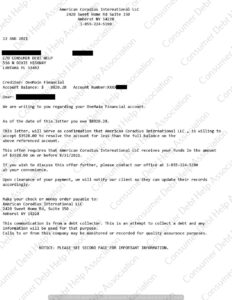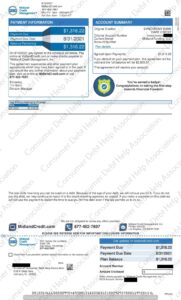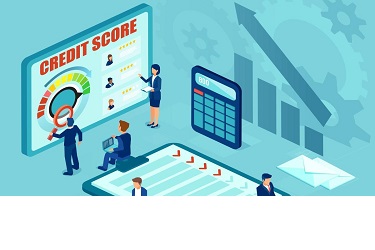Listen to one of our clients getting the exciting news of finishing the program and his reaction to it ! This shows Consumer Debt Help Association gets done what we promise !
Audio PlayerSettlement Letter from Smile Generation/Comenity Bank
Consumer Debt Help Association, Debt Relief Specialist wants to share a settlement letter from Smile Generation/Comenity Bank. Bal. $4280.07 Offer $1285.00 Savings $2995.07

Settlement Letter from One Main
Consumer Debt Help Association, Debt Relief Specialist wants to share a settlement letter from One Main. Bal. $8820.28 Offer $3528.00 Savings $5292.28

Settlement Letter from Fingerhut/Web Bank
Consumer Debt Help Association, Debt Relief Specialist wants to share a settlement letter from Fingerhut/Web Bank. Bal. $2156.11 Offer $755.00 Savings $1401.11

Settlement Letter from Care Credit/Synchrony Bank
Consumer Debt Help Association, Debt Relief Specialist wants to share a settlement letter from Care Credit/Synchrony Bank. Bal. $2929.37 Offer $1318.22 Savings $1611.15

How Often Does Your Credit Score Update?
When you start to use credit cards and take out loans, you build a credit score that demonstrates your creditworthiness. Does that number stay static a day, a week, a month? In truth, it’s changing all the time.
Most of your accounts probably report information to the credit bureaus every 30 to 45 days. One more consistent on-time payment made may barely affect a score, but a missed payment might have a significant effect.
The higher your score is, the better you look to potential lenders because you’re a lower risk.
How often does your credit score update? Let’s find that answer and how to keep an eye on credit history and credit score.
When Do Credit Reports Update?
Whenever consumers take some sort of action relating to their credit, their score, usually a number between 300 and 850, will fluctuate.
For instance, if they apply for a loan or miss a credit card payment, their score could change.
There is no set date for a credit score update because a lender or creditor may send information to the three main credit bureaus at different times: Experian one day, Equifax five days after that, and TransUnion a week later.
An update, though, will occur at least every 45 days.
Rather than constantly checking for updates, it might be better to focus on long-term goals like paying off debt, making sure payments are sent on time, and ensuring that scores are going in an upward direction.
How Credit Scores Size Up
Lenders most often use FICO® Scores, but the credit bureaus introduced the VantageScore® in 2006 to provide a score that was more consistent among the three credit agencies.
FICO
•Exceptional
800-850
•Good
670-739
•Fair
580-669
•Very Poor
300-579
VantageScore
•Excellent
781-850
•Good
661-780
•Fair
601-660
•Poor
500-600
•Very Poor
300-499
This is how the FICO Score 8 and the latest VantageScore models break down above:
People with high scores typically have access to higher lines of credit and lower interest rates. Those with low credit scores may not be approved for certain credit cards and loans, and if approved for, say, a mortgage, will usually pay a much higher mortgage interest rate.
(That said, a conventional mortgage lender is free to set its own requirements when it comes to credit scores. Government-backed loans still have credit score requirements, even if they’re lower.)
How To Check a Credit Report
Under federal law, consumers are entitled to one free copy of their credit report every 12 months from each of the main credit reporting agencies, TransUnion, Experian, and Equifax.
AnnualCreditReport is the only authorized website for free credit reports, according to the Federal Trade Commission.
Consumers can also call 1-877-322-8228 and provide their name, address, Social Security number, and date of birth to verify their identity.
If you want to check your credit history more than once a year, you can ask one or all three credit reporting bureaus, for a small charge, for another copy.
Why check your credit report periodically? Mainly:
• To make sure the information is accurate and up to date before you apply for a car or home loan, buy insurance, or apply for a job.
• To help guard against identity theft.
How To Check a Credit Score
The free annual credit reports do not include your credit score, or more accurately, scores—your credit score from each of the credit bureaus will vary based on the information each has. Lenders also use slightly different credit scores for different kinds of loans.
How to get your credit scores then? Here are a few ways:
• Buy a score directly from the credit reporting companies or from myfico.com.
• Look at a loan statement or a credit card statement. Some financial companies provide credit scores for customers as a perk.
• Use a credit score checker. Some services give consumers access to their credit scores but charge for premium services like checking a score daily. Other sites may require that you sign up for a credit monitoring service with a monthly subscription fee in order to get your “free” score.
• Sign up for an app like SoFi Relay, which provides free weekly updates on your credit score and tracks all of your money in one place.
When signing up for credit score checking websites, it’s important for consumers to look at the terms of service and ensure they’re not being charged for premium services they do not want.
Also, it’s best to avoid an “educational” credit score vs. a score that a lender would use. For some, there will be a meaningful difference, the Consumer Financial Protection Bureau says.
What Makes Up a Credit Score?
Learning about what factors make up a credit score can help consumers raise their scores. Main factors that contribute to the score, in order:
• Payment history (35-40%)
• Credit utilization
• Length of credit history
• New credit
• Credit mix
In terms of payment history, the most important factor when calculating a score, it’s critical to always repay debts on time.
The credit utilization ratio is the amount that is owed in relation to how much credit a person has overall. Keeping your credit utilization ratio below 30% is commonly recommended.
For the length of the credit history, consumers can increase their score by not closing cards. The longer someone’s credit history is, the better.
Applying for new credit cards and loans that require a hard inquiry into a credit report could bring down a score, even if the result is approval. However, if a score does go down, it shouldn’t take long for it to go back up. It’s multiple hard inquiries on a credit report in a short period that can cause damage. Then again, if someone is shopping for a mortgage or auto loan, both FICO and VantageScore account for multiple hard inquiries in a grace period of 14 to 45 days.
Credit mix refers to credit cards, student loans, auto loans, personal loans, and mortgages. By having a mix, consumers show that they can manage all kinds of debt.
Why Credit Scores Matter/
Having a high score can help consumers in a number of scenarios.
They will save money, and potentially a great deal of money if they gain access to lower interest rates.
The higher a score is, the more credit someone will be able to access as well.
Consumers can reach their financial goals quicker and utilize better products. For example, they may get approved for a credit card that offers perks like bonus travel rewards or a high cash-back rewards rate. They might also be able to use a card with a 0% introductory APR or 0% balance transfer rate for a certain period.
People with a high score may be able to rent a better apartment or home since landlords will check prospective tenants’ credit.
They may gain access to better car insurance rates and be able to avoid paying deposits to utility companies and cellphone providers.
Improving a credit score could take time, but it’s worth it because in the long run, consumers will save money and potentially reach their financial goals that much faster.
The Takeaway
How often does your credit score update? All the time, really, but once a month is a good barometer. You can order a free credit report every year, or you can see updates in your credit score for free or for a fee.





